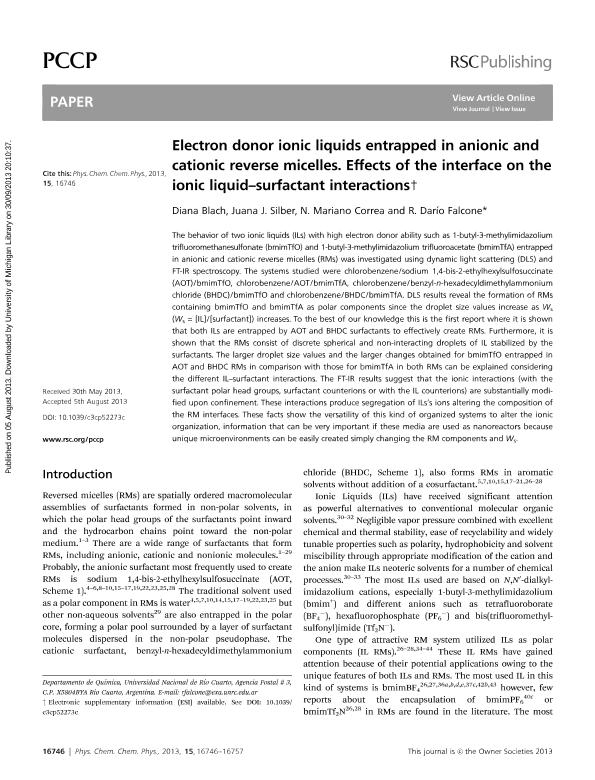Mostrar el registro sencillo del ítem
dc.contributor.author
Blach Vargas, Diana

dc.contributor.author
Chessa, Juana Josefa

dc.contributor.author
Correa, Nestor Mariano

dc.contributor.author
Falcone, Ruben Dario

dc.date.available
2017-09-11T18:30:54Z
dc.date.issued
2013-08
dc.identifier.citation
Blach Vargas, Diana; Chessa, Juana Josefa; Correa, Nestor Mariano; Falcone, Ruben Dario; Electron donor ionic liquids entrapped in anionic and cationic reverse micelles. Effects of the interface on the ionic liquid–surfactant interactions; Royal Society of Chemistry; Physical Chemistry Chemical Physics; 15; 39; 8-2013; 16746--16757
dc.identifier.issn
1463-9076
dc.identifier.uri
http://hdl.handle.net/11336/23919
dc.description.abstract
The behavior of two ionic liquids (ILs) with high electron donor ability such as 1-butyl-3-methylimidazolium trifluoromethanesulfonate (bmimTfO) and 1-butyl-3-methylimidazolium trifluoroacetate (bmimTfA) entrapped in anionic and cationic reverse micelles (RMs) was investigated using dynamic light scattering (DLS) and FT-IR spectroscopy. The systems studied were chlorobenzene/sodium 1,4-bis-2-ethylhexylsulfosuccinate (AOT)/bmimTfO, chlorobenzene/AOT/bmimTfA, chlorobenzene/benzyl-n-hexadecyldimethylammonium chloride (BHDC)/bmimTfO and chlorobenzene/BHDC/bmimTfA. DLS results reveal the formation of RMs containing bmimTfO and bmimTfA as polar components since the droplet size values increase as Ws (Ws = [IL]/[surfactant]) increases. To the best of our knowledge this is the first report where it is shown that both ILs are entrapped by AOT and BHDC surfactants to effectively create RMs. Furthermore, it is shown that the RMs consist of discrete spherical and non-interacting droplets of IL stabilized by the surfactants. The larger droplet size values and the larger changes obtained for bmimTfO entrapped in AOT and BHDC RMs in comparison with those for bmimTfA in both RMs can be explained considering the different IL–surfactant interactions. The FT-IR results suggest that the ionic interactions (with the surfactant polar head groups, surfactant counterions or with the IL counterions) are substantially modified upon confinement. These interactions produce segregation of ILs’s ions altering the composition of the RM interfaces. These facts show the versatility of this kind of organized systems to alter the ionic organization, information that can be very important if these media are used as nanoreactors because unique microenvironments can be easily created simply changing the RM components and Ws.
dc.format
application/pdf
dc.language.iso
eng
dc.publisher
Royal Society of Chemistry

dc.rights
info:eu-repo/semantics/openAccess
dc.rights.uri
https://creativecommons.org/licenses/by-nc-sa/2.5/ar/
dc.subject
Reverse Micelles
dc.subject
Ionic Liquids
dc.subject
Aot
dc.subject
Bhdc
dc.subject.classification
Otras Ciencias Químicas

dc.subject.classification
Ciencias Químicas

dc.subject.classification
CIENCIAS NATURALES Y EXACTAS

dc.title
Electron donor ionic liquids entrapped in anionic and cationic reverse micelles. Effects of the interface on the ionic liquid–surfactant interactions
dc.type
info:eu-repo/semantics/article
dc.type
info:ar-repo/semantics/artículo
dc.type
info:eu-repo/semantics/publishedVersion
dc.date.updated
2017-09-06T19:02:04Z
dc.journal.volume
15
dc.journal.number
39
dc.journal.pagination
16746--16757
dc.journal.pais
Reino Unido

dc.description.fil
Fil: Blach Vargas, Diana. Universidad Nacional de Río Cuarto; Argentina. Consejo Nacional de Investigaciones Científicas y Técnicas; Argentina
dc.description.fil
Fil: Chessa, Juana Josefa. Universidad Nacional de Río Cuarto; Argentina. Consejo Nacional de Investigaciones Científicas y Técnicas; Argentina
dc.description.fil
Fil: Correa, Nestor Mariano. Universidad Nacional de Río Cuarto; Argentina. Consejo Nacional de Investigaciones Científicas y Técnicas; Argentina
dc.description.fil
Fil: Falcone, Ruben Dario. Universidad Nacional de Río Cuarto; Argentina. Consejo Nacional de Investigaciones Científicas y Técnicas; Argentina
dc.journal.title
Physical Chemistry Chemical Physics

dc.relation.alternativeid
info:eu-repo/semantics/altIdentifier/doi/http://dx.doi.org/10.1039/c3cp52273c
dc.relation.alternativeid
info:eu-repo/semantics/altIdentifier/url/http://pubs.rsc.org/en/Content/ArticleLanding/2013/CP/c3cp52273c#!divAbstract
Archivos asociados
